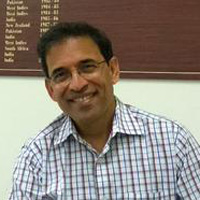Opinion Harsha Bhogle writes: Piyush Pandey, the man who took Indian ads to the world
Sometimes, the word “legend” gets used too easily, but Piyush was one in every sense of the word. He was a trailblazer
 Piyush Pandey helped take Indian advertising on to the global stage, producing mind-blowing work. Yet, the concepts were always so simple. And every time you met Piyush, you realised that greatness lay in simplicity.
Piyush Pandey helped take Indian advertising on to the global stage, producing mind-blowing work. Yet, the concepts were always so simple. And every time you met Piyush, you realised that greatness lay in simplicity. Piyush Pandey and I didn’t meet very often, but when we did, inevitably, the first thing we talked about was cricket. He played for his ad agency Ogilvy & Mather (O&M). He had played for Rajasthan before — he just loved cricket and had very good insights into it. We must have played the odd game against each other when he was playing for O&M and I was turning out for Rediffusion. But what I always wanted to know was what he was doing in advertising.
Sometimes, the word “legend” gets used too easily, but Piyush was one in every sense of the word. He was a trailblazer. When I met Piyush, I was a young person working in Rediffusion advertising. I looked up to its creative director, Kamlesh Pandey, who I thought was one of the finest Hindi writers I had met. Inevitably, he would write advertising copy in English, because that was the practice then. Back then, advertising was still largely an English-medium profession that demanded very beautifully nuanced, wonderfully written and well-conceived copy. But when we got him to do Hindi, he was magnificent.
Piyush made advertising very desi; he added to it what I have described in my tribute on X as zaika. He was very rooted — very “Hindi”, but with knowledge about the culture in other parts of the country, like Tamil Nadu and Andhra Pradesh. He came from an astonishing family — his sister Ila Arun sang ballads, his brother Prasoon Pandey made beautiful films. But they were all very rooted in the customs, ethos and festivities of India; they knew the country so well. And you could see the beautiful aspects of India coming through in Piyush’s work — whether he was doing advertising for Asian Paints, whether it was the long-running campaign for Fevicol, those great ads for Cadbury. He even did the initial ad for the IPL.
Piyush’s sensibilities were quintessentially Indian. And that changed advertising in the country for good — everybody started thinking in terms of “India”. Later, in the south, the thinking switched to Tamil, Telugu, etc., but thanks to Piyush’s work, we all started thinking in Hindi. I’ll give you an example of how “English” advertising used to be. In my early days, when working on a campaign, the art director would want to know if it would appear in the Sunday Observer. This was so that his social circle and his family could see the ad. Piyush Pandey changed this way of thinking. And for this, Indian advertising will always be grateful.
My dear friend Bharat Puri, who was one of the directors of Fevicol — he had made a name for himself as the country head of Cadbury earlier, and had been one of the brightest young stars in Asian Paints even before that — talked about the trust that had developed between him and Piyush. He would narrate how Piyush would just call him up and say, “yaar, yeh ek idea ban raha hai, main kar raha hoon (we are working on an idea, I’m doing this).” And Bharat would say, “haan kar de (go ahead)”. This trust was possible because they both understood the brand so beautifully.
Piyush Pandey helped take Indian advertising on to the global stage, producing mind-blowing work. Yet, the concepts were always so simple. And every time you met Piyush, you realised that greatness lay in simplicity. He ended up becoming one of the big names in global advertising, but all through, he remained deeply rooted in his Indianness. His death is a colossal loss to Indian advertising.
The writer is a cricket commentator who spent his early career in advertising





